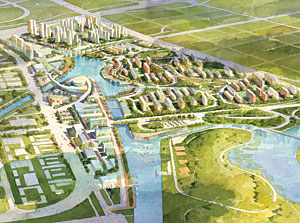In its master plan for the 2010 Guangzhou Asian Games, the U.S.- and Shanghai-based landscape architecture firm SWA Group looked to the past as well as the future—an approach that earned it a much larger commission than anticipated.

The firm was hired to design a master plan for three square kilometers on the outskirts of Guangzhou, a city of 6 million in southern China. The Asian Games village will include residential units, commercial space, and sports venues, with public open space interspersed throughout.
SWA principal Sean O’Malley started work on the project in 2006, and his initial designs mimicked the pattern of historic villages around Guangzhou—dense hamlets situated on wooded hilltops, surrounded by expanses of agricultural land. When local planners and officials saw his sketches, they expanded the project and asked the firm to design a master plan for a 30-square-kilometer area surrounding the Asian Games’ village. The goal was to create a series of suburbs that would relieve congestion in overcrowded Guangzhou.
SWA’s scheme combines land-use, landscape, and transportation strategies with the idea of clustered villages. Placing densely populated areas on elevated ground, with farmland in between, the plan breaks up the parcel into six discrete towns, each with its own residential, commercial, industrial, and open-space zoning. To facilitate movement between these centers, SWA takes advantage of existing canals and tributaries that run through the site, which borders Pearl River to the east. Expanding the waterways where necessary, the firm envisions harbors in each town as part of a water-based transit system that connects the communities to each other and to three proposed light-rail stations that will link the site to central Guangzhou, 20 kilometers away.
After the initial planning phase was completed in 2007, the project was taken over by six Chinese design institutes—once state-run, design institutes are private firms that maintain a close relationship with state and local government—each in charge of its own town plan. Construction of the Asian Games village, scheduled for August 2010, is already under way.
The incredible speed with which the project is unfolding caused O’Malley some worry about whether the intentions of his plan would be carried through. “It has been our experience that working in China is a mixed bag,” he says. “The longer you can stay involved, the more successful [you’ll be].” Despite those reservations, he expresses faith in the younger generation of Chinese architects, who he believes will be successful in creating an “urban fabric” with a range of public spaces outside of Guangzhou.

